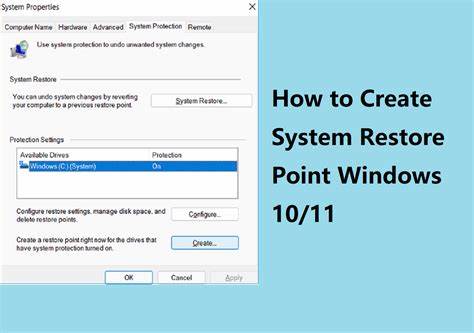Windows 10 includes a valuable feature called System Restore, which lets you roll your system back to a previous state using what’s called a restore point. These points capture system files, drivers, registry settings, and installed apps, giving you a recovery fallback if something goes wrong.
What is a Restore Point? A restore point is a snapshot of your system’s configuration at a specific time. It doesn’t touch your personal files (like documents or photos), but it can undo problematic system changes.
When Should You Create One?
- Before installing new software or drivers
- Before making system tweaks (e.g., registry edits)
- Before a major Windows update
- Periodically, just in case
How to Create a Restore Point in Windows 10
Step 1: Open System Properties
- Method A: Type “create a restore point” in the Windows search bar and select the result.
- Method B: Right-click Start > System > Click “System protection” in the left pane.
Step 2: Ensure Protection is On
- In the “System Protection” tab, check that protection is turned on for your system drive (usually C:).
- If it’s off:
- Select the drive > Click “Configure…”
- Choose “Turn on system protection”
- Set Max Usage to 5-10% and click OK
Step 3: Click “Create…”
- Click the “Create…” button at the bottom of the tab.
Step 4: Name the Restore Point
- Enter a descriptive name (e.g., “Before driver update”). Date/time are auto-added.
- Click Create.
Step 5: Wait for Confirmation
- Windows will take a few minutes.
- Once done, you’ll see “The restore point was created successfully.”
How to Use a Restore Point
- Open “System Properties” > “System Protection” tab
- Click “System Restore…”
- Follow the wizard:
- Click Next
- Select a restore point
- Optionally scan for affected programs
- Click Next > Finish > Yes to confirm
- Windows will restart and apply the selected restore point.
Tips & Warnings
- Not a full backup: Still back up personal files separately.
- Disk space: Ensure enough space for restore points.
- Safe mode: If needed, perform from Safe Mode.
- Plug in your laptop: Prevent power loss during the process.
By manually creating restore points, you’re building safety nets into your system workflow—a smart move for any user who customizes or frequently updates their PC.





